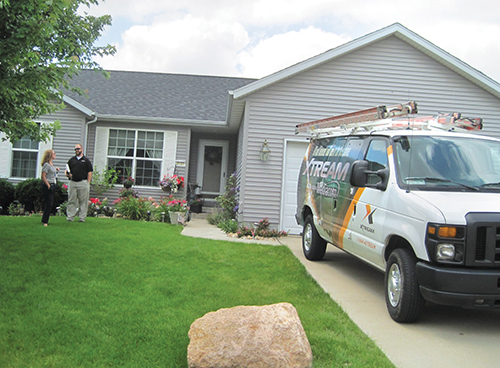
New president outlines goals; sustainability a focus with new acquisition
By Sarah Binder
CEDAR RAPIDS–It’s been around for nearly 120 years, but it’s not finished growing and changing.
Shive-Hattery, one of the Corridor’s largest engineering firms, announced in October the election of a new president and acquisition of Design Organization, a 29-person architecture firm with offices in Chicago and Indiana. The company is also adjusting to ongoing industry changes, including a move to more sustainable building practices and baby boomer engineers retiring in droves.
“My belief is, as president, the primary duty is to build an organization that builds a business,” said Thomas Hayden, who has been president of Shive-Hattery since 1995 and will continue as chairman of the board. “We’re much larger, much more successful, much more capable, and much more geographically diverse…we did it together. We built the organization that built the business.”
James Lee, the new president, said one of his major goals is to increase the company’s architectural capabilities. Shive-Hattery was purely an engineering firm before adding architecture during the 1980s.
“I’d like to raise the profile of our architectural and design capabilities,” Mr. Lee said. “Not that our engineering services are diminishing, but we’ve been able to grow.”
The acquisition of Design Organization helps Shive-Hattery expand those services, as well as expand geographically. Previously, Shive-Hattery operated an office in the Chicago suburbs, but said having Design Organization’s office in Chicago makes a big difference.
“That opens up a new market for us,” Mr. Lee said. “Our clients in our industry, especially our government clients, tend to be pretty parochial.”
Mr. Lee predicted future growth at Shive-Hattery could come from acquiring other companies, growing their existing offices and most importantly, expanding internationally. The company could follow some of its Fortune 500 clients as they expand and build around the world, he said.
“We’ve kind of got our toe in the water right now in a couple places, but I think there’s an opportunity there,” Mr. Lee said.
The challenge of future growth, however, is expected to be a smaller pool of architects and engineers to choose from. Fewer high school students are entering those fields and just as many engineers plan to retire. Mr. Lee estimated the company will need to plan for 19 percent more hiring to keep a steady workforce.
“There’s real concern about the labor pool that’s going to be available,” he said.
He would like to be more involved with talking to students as young as junior high about architecture and engineering. Shive-Hattery already has an established intern program that lets them “test-drive top talent” at the college level.
“If we see a star in our internship program, we want them to come to Shive-Hattery once they graduate,” Mr. Lee said.
Reflecting on a career
 Mr. Hayden plans to officially retire at the end of March. He has been with Shive-Hattery since 1974.
Mr. Hayden plans to officially retire at the end of March. He has been with Shive-Hattery since 1974.
“We’re old enough to have slide rules,” he said. “The technology, like so many industries, has made giant changes for us.”
One of his most significant accomplishments was meeting with each employee in each office twice per year, to hear their thoughts on the company directly.
Another accomplishment was weathering the economic downturn of 2008, when many architecture and engineering firms were forced to close. While flood recovery in the Corridor was one factor in the company’s ongoing success, Mr. Hayden said it’s more due to a strategy Shive-Hattery developed 50 years ago: to diversify both services offered and their types of clients.
“They realized that was the best strategy for them, and that tends to protect you from the down times,” Mr. Hayden said.
Shive-Hattery serves clients in retail, education, government, healthcare, industry and telecommunications industries. Because of this, they don’t have the “high highs” when one sector is growing, Mr. Hayden said, but they have had more stable growth.
Mr. Hayden said he believes in a few basic principles that have been his mantra since he started: taking care of clients, providing outstanding service, creating a good place to work and being financially successful.
“Fail at any one of these, you’re going to put your company at risk,” he said.
A sustainable workplace

One of the capabilities that Design Organization brings to the company is experience designing corporate workplaces, which Mr. Lee described as going “way above and beyond interior design of office space.”
“It’s how to make their workplace more comfortable, more efficient, more inviting,” he said.
Jeff Lewis, a principal at Design Organization and team leader of the Chicago office, was an early adopter of the LEED (Leadership in Energy and Environmental Design) certification system. He recalled working on one of the nation’s first LEED projects, creating an office to integrate former Amoco staff with BP staff after the companies merged.
“This project in particular, was a catalyst for change,” he said, noting that Amoco had a very hierarchical organizational chart, where BP was more equal and it was reflected in the design.
“You could walk through the building and identify an Amoco floor versus a BP floor based on how much open space it had,” Mr. Lewis said.
When designing a corporate workplace, Design Organization considers factors such as lighting, temperature, views of the outdoors, cubicle height, workstation size, and ratio of open space to private rooms and offices.
An open floor plan, with fewer private offices and equal-sized workstations, is usually optimal because it can be easily rearranged, he said. However, creating more open space can require a shift in company culture, from protocols for phone use to whether it’s ok to work sitting on a sofa.
“Good workplace planning reinforces the culture of the company, but it also creates a healthy work environment,” Mr. Lewis said. “Typically, if we’ve done it right, the individual worker is very very happy.”
He said that often, creating a happy workplace and a sustainable workplace go hand in hand and that simple changes like bringing plants into the office can have a big effect on worker happiness.
Mr. Lee noted that between Shive-Hattery and Design Organization, the company has worked on several LEED projects. Mr. Lee has led Shive-Hattery’s sustainability committee since 2009 and said the company take the environmental impacts of the construction industry very seriously, even on non-LEED projects.
“The main thing I try to get across is the LEED system is a good rating if you want to keep score,” he said. “What I try to emphasize to everyone, it’s about doing the right thing for the environment, more than getting a plaque on the wall.”




